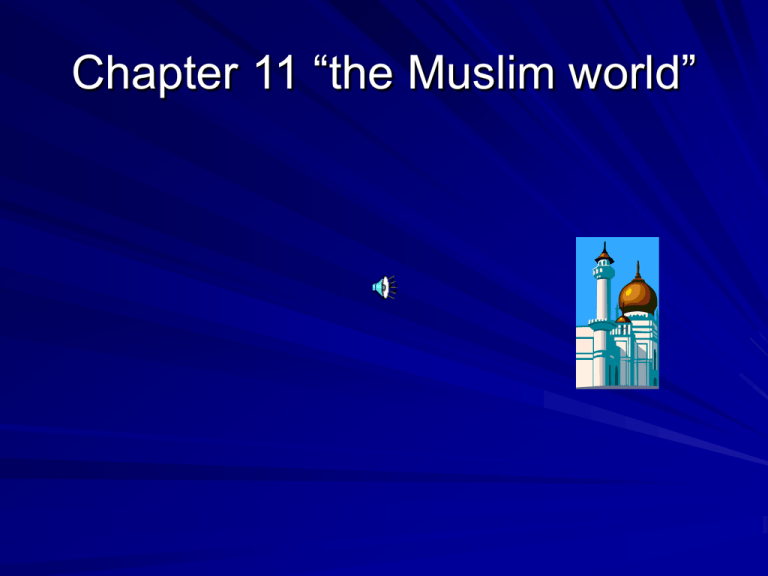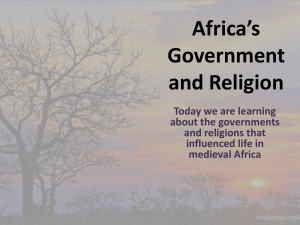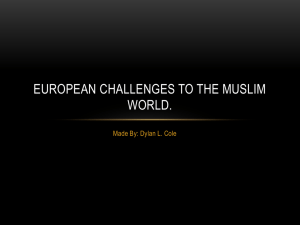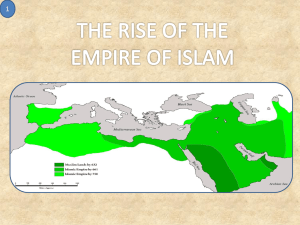
Chapter 11 “the Muslim world”
The Kabba
The Prophet Muhammad
The religion of Islam began in the Arabian Peninsula, in southwestern Asia.
Most Arabs were nomads who herded goats and camels.
Islam was founded by a prophet named Muhammad. Muhammad was born
in 570 A.D. in the city of Mecca. Around the year 610, he had a vision of
the angel Gabriel, who told him that God had chosen him as a prophet.
Muhammad urged people become monotheistic and convert to Islam. This
did not sit well with the people who worshipped traditional Arab gods.
In the year 622, Muhammad, faced with the threat of murder, left Mecca for
Medina, a journey called the Hijira.
In the year 630, Muhammad returned to Mecca, where he destroyed idols
of Arab gods and goddesses in the Kabaa, and ancient shrine believed to
have been built by the prophet Abraham.
Muhammad died in 632 A.D.
Muslim Beliefs
The Quran is a Muslim holy book which contains the sacred word of God as
revealed to Muhammad. It teaches about God and offers a complete guide
to Muslim life.
The Sharia is a system of law that interprets the Quran. It controls moral
conduct, family life, and other parts of Muslim parts.
All Muslims accept five basic duties called the Five Pillars of Islam. They
are:
1.
Declaration of the faith
2.
Prayer five times a day
3.
Charity to the poor
4.
Hajj
5.
Ramadan fasting
Muslims believe in one God, named Allah, and in Muhammad as the
prophet.
The Islam religion has no official priests or religious hierarchy.
Muslims are not allowed to eat pork, drink alcohol, gamble, or worship
idols.
The Spread of Islam and Muslim
civilization
Arab armies conquered great chunks of the Byzantine empire, and the Persian
empire
In 732 the Arab push into Europe was turned back by the battle of Tours
The Arabs had camel and horse cavalry and generations of living in the desert , and
their common faith in Muhammad
They taxed non Muslims but allowed Christians, Jews and Zoroastrians to practice
their own faith.
People choose Islam as their religion because its message was simple and direct
Many Jews and Christians played key roles as officials, doctors, and translators.
Rules of Islam
There was no class of priests
Islam made sure everyone was equal regardless of race, sex, class, or wealth
Spain was the biggest populated Muslim country in Europe
In the early middle ages the Arabs took control over Sicily , but since there was not
many troops there they lost they land to knights from Normandy
There were two types of Muslims , the Sunnis and Shiites
The Sunnis felt that the caliph should be chosen by leaders of the Muslim church
Muslim view on human
anatomy
Shiite, Muslim, and Umayyad peoples
They thought the caliph should be a pious and they viewed him as a leader not a
religious authority
The shiites that that only the true successors to the prophet were descendants of
Muhammad’s son and daughter – in-law
Their inspiration came from the example of Muhammad as recorded by his early
followers
Sufi were Muslim mystics who sought communion through god through rituals
The Umayyad dynasty ruled the Islamic world until 750.
The Shiites hated the Umayyads because they defeated Ali, and killed his son.
The Abbassid Dynasty, Seljuk Turks, and Genghiz Khan
The Abbassid Dynasty ended Arab dominance and helped make Islam a truly
universal religion.
Baghdad exceeded Constantinople in size and wealth under the Abbassids
Harun al-Rashid ruled an empire larger than that of his European contemporary
Charlemagne
The Seljuk Turks controlled Baghdad, and left the Abbassid caliph as a figure
head.
During the Crusades, Jerusalem passed back and forth between Muslims and
Christians.
Genghiz Khan who led the Mongol army Burned and looted Baghdad and later
adopted Islam.
Muslims in India
India fragmented into many local kingdoms in 550.
The sultan of Ghur made Delhi his capitol, which his successors organized the
Delhi sultanate, which lasted from 1206 1526.
Tamerlane invaded India then plundered the northern plain and smashed into
Delhi in 1398.
Muslim advance brought two totally different religions and cultures, Hindus and
Muslims, face to face.
Although Hindus remained second-class citizens, as long as they paid the nonMuslim tax they could practice their own religion.
During the period of cultural blending Indian Muslims absorbed elements of
Hindu culture such as marriage customs and caste ideas.
arabesque tiles
Turkish and Mongol invaders and the Mughal dynasty
Babur, the head leader of Turkish and Mongol invaders, swept away the remnants of
the Delhi sultanate and set up the Mughal dynasty which ruled from 1526 to 1857.
Akbar, Babur’s grandson, was the chief builder of the Mughal Empire, Under Akbar a
strong central government was created.
Jahangir was a weaker ruler than his father, Akbar; he left most details of government
in the hands of his wife, Nur Jahan.
During the reign of Shah Jahan, Akbar’s grandson, was when the Mughal dynasty
reached it’s high point.
In the late 1600’s Aurangzeb resumed the persecution of Hindus.
Economic hardships increased because of heavy taxes, and displeasure sparked
revolts against Mughal rule.
The Ottoman and Safavid Empires
The Ottomans were Turkish-speaking nomadic people
who migrated from Central Asia to northwestern Asia
Minor.
The Ottoman Empire experienced a golden age under
the sultan Suleiman, who ruled from 1520 to 1566.
Sulieman strengthened the Ottoman government by
ruling with the help of a grand vizier and a council. He
established a bureaucracy that supervised the
business of government. Ottoman painters produced
detailed miniatures and manuscripts. A royal architect
named Sinan designed hundreds of mosques and
palaces.
Under the ruler Shah Abbas the Great, the Safavid
empire too, experienced a golden age. Shah Abbas
managed to revive to the glory of ancient Persia by
centralizing the government and creating a powerful
military force based on that of the Ottomans.
Shah Abbas the Great
Ottoman social classes
The Ottoman people were divided
into four social classes:
1.
“Men of the pen” – scientists,
lawyers, judges, and poets
2.
“Men of the sword” – soldiers
3.
“Men of negotiation” –
merchants, tax collectors, and
artisans
4.
“Men of husbandry” – farmers
and herders
Muslim Trade and Culture
Muslim merchants built a huge trading network across the Muslim world and beyond.
Arab merchants brought Arabic numerals from India to the western world, as well as
sugar from India and papermaking from China.
Merchants created new ways of doing business. They made partnerships, bought
and sold on credit, built banks to exchange currency, and invented the ancestor of
today’s bank checks.
Artists were forbidden by the Quran and their religious leaders to portray God and
human figures in religious art. Mosques were decorated with complex abstract and
geometric patterns.
The arabesque is an elaborate design made up of curved lines that suggest floral
shapes. It appeared in Muslim rugs, textiles, and glassware. Muslim artists also
perfected skills in calligraphy.
Muslim architects adapted the domes and arches of the Byzantine buildings to their
own. In Jerusalem, they built the Dome of the Rock, a great shrine topped with a
beautiful dome.
Poets developed elaborate formal rules for writing poetry and explored both religious
and worldly themes. Muslim writers also cherished the art of storytelling. The bestknown collection of tales is The Thousand and One Nights, a group of stories
narrated by the fictional princess Scheherezade.
Ottoman empire
Muslim Science
• Muslim scholars, such as Ibn Khaldun, stressed the
•
•
importance of studying the causes of events, and set
standards for the scientific study of history.
Muslims studied both Indian and Greek mathematics.
The greatest Muslim mathematician, al-Khwarizmi,
pioneered the study of algebra, and wrote a book that
later became a standard mathematics textbook in
Europe.
Astronomers studied eclipses, observed the Earth’s
rotation, and calculated the approximate circumference
of the Earth.
More Muslim science
The Muslim government set up hospitals, and forced
physicians and pharmacists to pass a test before they could
practice.
One of the most original medical thinkers was Muhammad alRazi. He wrote many books on medicine and challenged
traditional medical practices. He told doctors to treat the mind
as well as the body by making hopeful comments, which he
said would hasten patient’s recovery period.
Another highly respected physician was Ibn Sina, known in
Europe as Avicenna. He wrote a huge encyclopedia, called
the Canon on Medicine, which consisted of what the Greeks,
Arabs, and he himself had learned about the diagnosis and
treatment of disease.
Also, Muslim eye surgeons developed a way to treat
cataracts.








